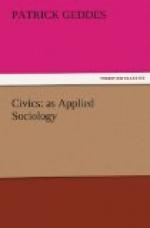Ancient | recent | contemporary | incipient ------------------------------------------------------------
---------------------------------------------- Primitive | Matri- | Patri- | Greek | Mediaeval | Renaissance | Revolution | Empire | Finance | ? ? ? | archal | archal | and | | | | | | | | | Roman | | | | | |
which, were it placed erect, we might now compare to the increasing [Page: 110] nodes of a growing stem, or rather say the layers of a coral reef, in which each generation constructs its characteristic stony skeleton as a contribution to the growing yet dying and wearying whole. I have elaborated this example of the panoramic aspect of Old Edinburgh as a widely familiar instance of the method of literal survey with which social and civic studies may so conveniently begin; and I press the value of extending these even to the utmost elaborateness of photographic survey: in my view, indeed, a sociological society has at least as much use for a collection of maps, plans and photographs as of statistics, indeed scarcely less than one of books. Of course, in all this I am but recalling what every tourist in some measure knows; yet his impressions and recollections can become an orderly politography, only as he sees each city in terms of its characteristic social formations, and as he utilises the best examples from each phase towards building up a complete picture of the greatest products of civic evolution, temporal and spiritual, of all places and times up to the present. Such a parallel of the historic survey of the city to that of its underlying geological area is thus in no wise a metaphoric one, but one which may be worked out upon maps sections and diagrams almost completely in the same way—in fact, with little change save that of colours and vertical scale. The attempt to express the characteristic and essential life and thought of a given region in each period upon a series of maps is in fact the best method of understanding the everyday map at which we commonly look so unthinkingly.
Much of the preceding, I am assured, must be most unsatisfactory to those who look at cities only from the standpoint of so many committees dealing with police, water, finance, and so on; or to those who are content to view the magnitude, the wealth and the population, the industries and the manufactures of a great city without considering whence these have come and whither they are leading; equally unsatisfactory also, I fear, to those to whom civic dignities and precedence, or the alternations of winning political colours, appear of prime importance. I can only hope that some of these may, on consideration, admit that the points of view I have endeavoured to outline above may be worth some thought and study as elementary preliminaries to their own more special and developed interests; and if the society permit. I hope to approach these more closely in a later paper.




